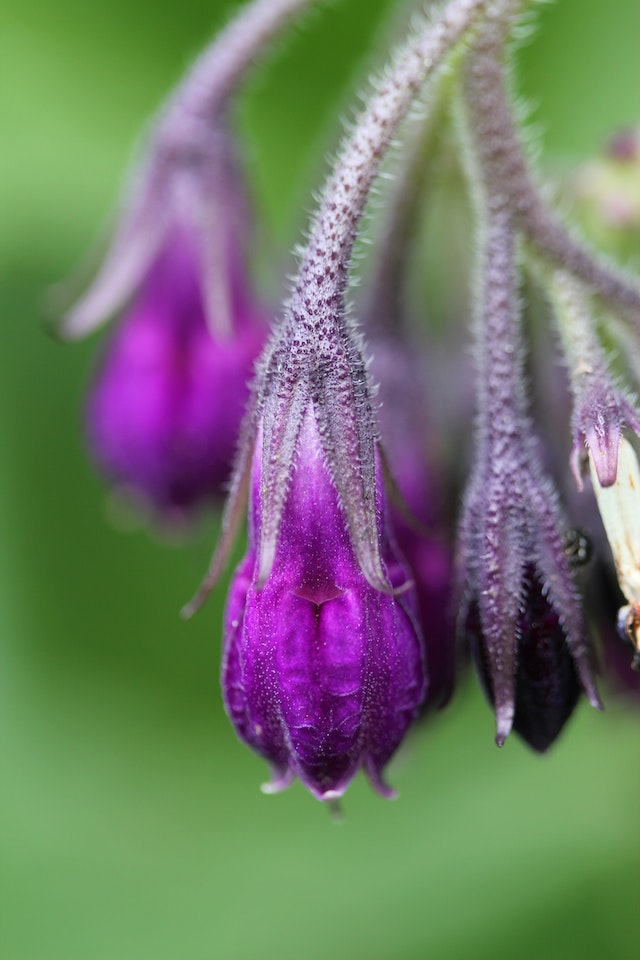Botanical Description:
Scientific Name: Symphytum officinale
Family: Boraginaceae
Description: Comfrey is a perennial herb with a robust and hairy stem that can reach a height of 2-3 feet. The plant has large, lance-shaped leaves that are covered in coarse hairs. Comfrey bears bell-shaped flowers, typically purple, pink, or white in color, arranged in clusters. The plant has a deep taproot, and it thrives in moist, fertile soils. Comfrey is native to Europe and Asia but has spread to various parts of the world. It’s often found along riverbanks and in damp meadows.
Disclaimer:
This Materia Medica is provided for informational purposes only and should not replace professional medical advice. Please consult with a qualified healthcare practitioner or herbalist before using any herbal remedies.
Therapeutic Actions:
- Demulcent and Emollient: Comfrey is known for its demulcent properties, providing a soothing and moisturizing effect on the skin and mucous membranes.
- Anti-inflammatory: Traditionally used for its anti-inflammatory effects, Comfrey may help in reducing inflammation and swelling.
- Wound Healing: Comfrey is renowned for its wound-healing properties, promoting tissue repair and regeneration.
- Bone and Tissue Repair: It has been historically used for fractures, sprains, and strains due to its association with supporting bone and tissue repair.
Constituents:
- Allantoin: A key compound in Comfrey, allantoin is believed to contribute to the herb’s regenerative and wound-healing properties.
- Mucilage: Comfrey contains mucilage, providing a soothing and demulcent quality.
- Tannins: Tannins in Comfrey contribute to its astringent properties.
Traditional Uses:
- External Applications: Comfrey has a rich history of external use for various skin conditions, wounds, cuts, and bruises.
- Musculoskeletal Support: Traditionally applied topically or used in poultices for musculoskeletal issues, including fractures, sprains, and joint pain.
- Respiratory Soother: In some traditional practices, Comfrey has been used for respiratory conditions, where demulcent properties may be beneficial.
- Gardener’s Friend: Known as “knitbone,” Comfrey has been used by gardeners for its reputed ability to enhance soil fertility and compost.
Dosage and Preparation:
- Comfrey Salve or Cream: External preparations such as salves or creams are commonly used for skin issues, wounds, and bruises.
- Compress or Poultice: For musculoskeletal concerns, a poultice or compress can be made using fresh or dried Comfrey leaves.
- Infusion for Respiratory Support: Infusions made from dried Comfrey leaves may be used for respiratory conditions. However, internal use is controversial, and caution is advised.
Cautions and Considerations:
- Pyrrolizidine Alkaloids: Comfrey contains pyrrolizidine alkaloids, which can be hepatotoxic in high concentrations. Internal use of Comfrey is generally discouraged.
- External Use Only: Due to the presence of pyrrolizidine alkaloids, Comfrey is primarily recommended for external use. Avoid internal use without professional guidance.
- Avoid Open Wounds: Comfrey should not be applied to open wounds or broken skin due to its potential to be absorbed into the bloodstream.
Conclusion:
Comfrey, with its storied history in traditional herbalism, stands out for its skin-soothing, anti-inflammatory, and tissue-regenerating properties. Its use in external applications for wound healing and musculoskeletal support has made it a staple in herbal medicine cabinets. However, the presence of pyrrolizidine alkaloids, which can be toxic to the liver, warrants caution. External use, particularly in the form of salves or poultices, can offer benefits without the same level of risk associated with internal use. As with any herbal remedy, consulting with a qualified healthcare practitioner or herbalist is crucial to navigate the complexities and ensure safe and effective use. Comfrey, when used judiciously and with proper guidance, remains a valuable ally in promoting external healing and overall well-being.





